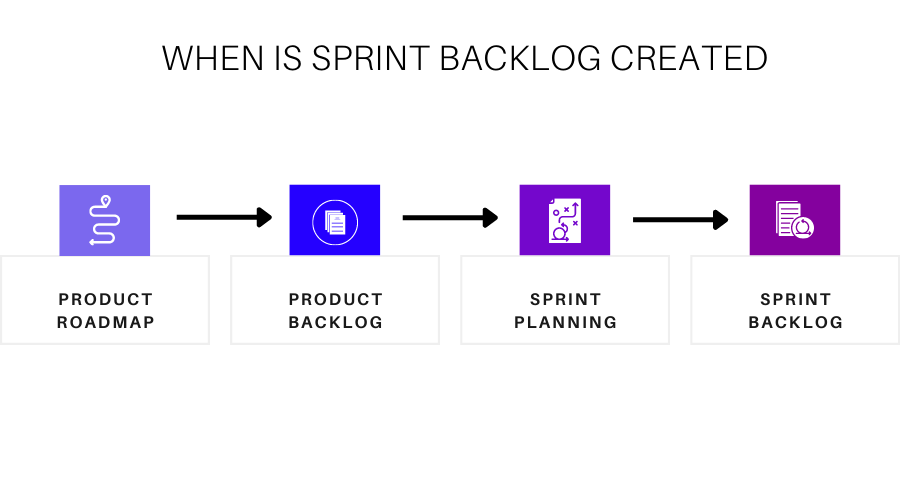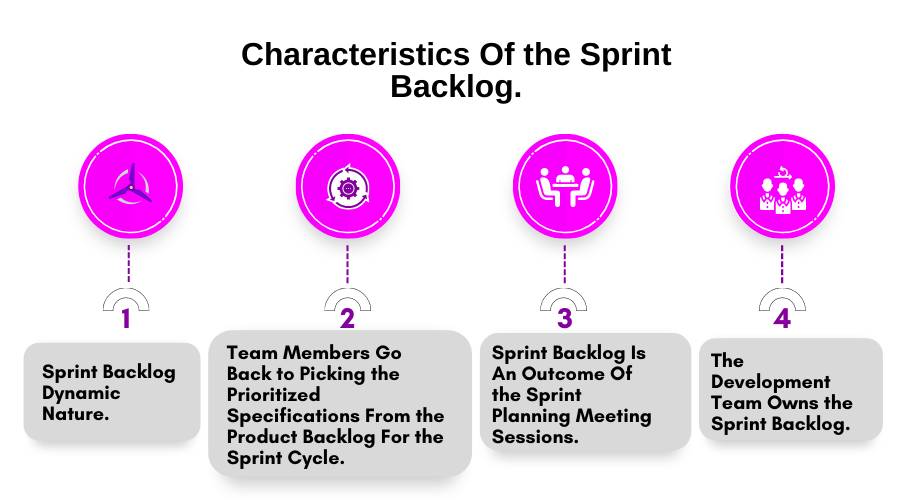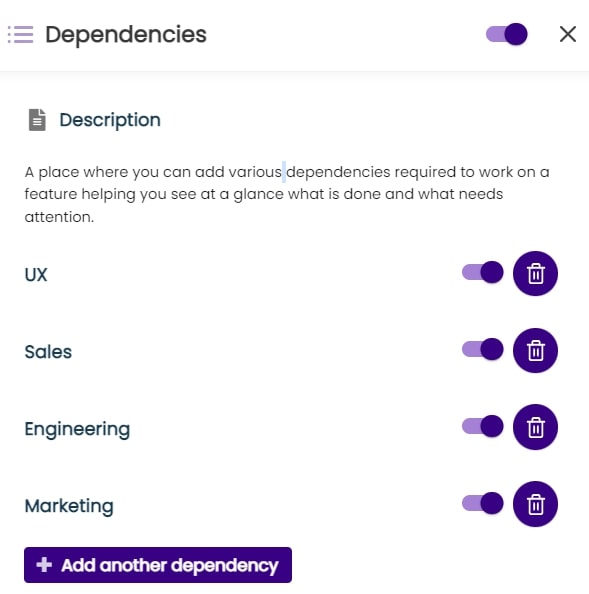Sprint Backlog: A Definitive Guide

This article covers:
- What Is Sprint Backlog?
- What Is a Sprint Backlog Example?
- When Is the Sprint Backlog Created?
- Who Creates the Sprint Backlog?
- What Is Included in a Sprint Backlog?
- How Detailed Should the Sprint Backlog Be?
- Release Backlog vs. Sprint Backlog
- Who Owns the Sprint Backlog?
- Who Can Execute the Work of the Sprint Backlog?
- When Is New Work Added to the Sprint Backlog?
- Conclusion
Members of product teams have heard of sprints in scrum and agile, and some may even know what it is.
But do you know what the sprint backlog is?
The sprint backlog lists the tasks that the team should complete within the duration of a sprint.
It includes everything from user stories to bugs.
Any team member can use it during their work on the project.
Read more on what to include in a sprint backlog, how it works, who owns it, who creates it, and when.
What Is Sprint Backlog?
Sprint backlog is the list of tasks that a team should complete in sprints or iterations.
These tasks can include anything from user stories, bugs, and different kinds of work for the project team members.
During daily scrum meetings, you can update the sprint backlog through discussions between developers and managers.
Sometimes, these discussions also include the business stakeholders.
Later, your team can prioritize and divide these discussed tasks into relevant sprints.
The team is accountable for completing the tasks in the list as per deadlines determined by their product manager. This will lead to successful project delivery on time.
The purpose of a sprint backlog is to provide visibility on what you need to do and by when. Thus, it also helps to estimate the time required for tasks.
We need a sprint backlog before any sprint to estimate the time taken for tasks and allocate it accordingly.
The advantages of a sprint backlog are that it helps to prioritize, divide and organize tasks into sprints.

One of the benefits of a sprint backlog is that it gives team members an idea of how much work they will complete in one week.
For example, suppose someone sees five tasks on their list and knows each task takes two hours to complete.
In that case, this person can expect to finish ten work hours by Friday evening. This estimation helps team members plan their personal and family lives.
A backlog’s disadvantage is that they don’t contain deadlines for task completion, so there is no accountability in the system.
A team member can take on any number of tasks at once and delay one or more without getting penalized.
Now that you know what a sprint backlog is let’s understand it better with the help of a sprint backlog example.
What Is a Sprint Backlog Example?
There can be a wide range of sprint backlog examples.
The sprint backlog example will be any task or activity you must accomplish in a single sprint.
It can include user stories, fixing bugs, technical debt issues, and more.
You create the items during product backlog grooming sessions before each sprint begins. For now, let’s consider the sprint backlog example from software development.
A good sprint backlog example is the bug list.
The sprint backlog example will also include any other items related to bugs like who reported them and when.
The bug list is a great example of a sprint backlog because it lists tasks the development team should complete.
A bug, in this context, refers to an error or problem with code that your team should fix.
Product owner owns the sprint backlog, and their input and approval are crucial before adding an item into a sprint backlog.
The development team can typically create this item in sprint planning without consulting them.
However, they should have already discussed all of their bugs with them at some point during the project.
Such a discussion informs them about what is fixed, remains unfixed, and has been deferred for future updates.
The development team should always have a clear idea of how many bugs are currently in the backlog.
Suppose you will add more than the average number to it during sprint planning meetings. In that case, they can either address these concerns ahead of time or add them to the product backlog.
Bonus: Read our blog about The Art of Sprint Planning: An In-Depth Guide to the Productive Process.
Apart from this, another sprint backlog example is a new feature lined up for a product. This includes stories, epics, and sub-tasks (i.e., tasks that make up a story).
Having understood the sprint backlog, let’s know who creates the sprint backlog and when.
When Is the Sprint Backlog Created?
You can create the sprint backlog when the team meets to discuss what they will be working on in the next sprint.
In other words, the sprint backlog emerges during the sprint planning stage.
It is crucial to create a sprint backlog during sprint planning. Such planning helps to know what can facilitate better transparency.
You can create the sprint backlog in minutes by writing everything down on paper or on a whiteboard. Then, you can prioritize it as per business value and other factors.
Without creating the sprint backlog, it is difficult for the team to know what they should be working on. It is nearly impossible to start a sprint without creating a sprint backlog.
The next thing you need to do after creating a sprint backlog is to include tasks you need to complete user stories. Other activities will include grooming, coding, testing, and more.
A task may include adding new features or fixing bugs, so it’s important not to leave anything out.
Each team should have a task owner to implement tasks related to completing user stories.
Remember that the team members who are not involved in a particular task must also stay updated on what’s happening.
They should follow up regularly and ask questions when needed. This ensures that all the team members support the team whenever there is a need.
When creating a sprint backlog, remember not to put too many tasks. Especially do not put the tasks you won’t complete or may start.
Such a practice will only cause confusion and stress among the team members.
Ensure that you take such precautions while creating the sprint backlog. Remember that assigning the task of creating the sprint backlog is vital to someone.

Bonus: Read about Product Backlog Items Responsibilities that can help you manage them better.
Who Creates the Sprint Backlog?
A product owner creates the list of tasks in the sprint backlog.
They may delegate this responsibility to a scrum master if they wish.
The product owner’s job includes determining which tasks to include and prioritizing them as per the business value.
The product owner is the person or team member working with stakeholders to prioritize requirements.
It is crucial to gather input from other team members about which they make user stories in each sprint.
In this case, the scrum master’s job includes creating a prioritized list of user stories needed by the end of a sprint for an achievable goal.
They will need input from others on what needs to build in each sprint.
In the next section, you’ll understand what is included in a sprint backlog.
What Is Included in a Sprint Backlog?
A sprint backlog includes all the tasks a team expects to complete over an iteration.
They are usually tracked by story points and organized in priority order for estimation, planning, and efficient completion.
Sprint backlog consists of product backlog items that you must complete in each sprint. It helps the team to know what to-dos are in line for them.
However, each backlog is uniquely tailored based on what needs to happen in each sprint.
There are some common items you’ll see across all scrum sprint backlogs. They are listed below:
- Releases: Unfinished work from the sprint that is not ready to be released yet. This includes past releases and future releases.
- Completed Tasks: Tasks completed in a previous iteration or related tasks needed for release.
- Work In Progress (WIP): Any unfinished task that should be completed before the next iteration.
- Backlog: All items in a sprint backlog, regardless of their status.
These components in a sprint backlog create a framework for the team to work within.
In other words, the scrum sprint backlog provides a structure for what needs to happen in each project iteration.
It identifies incomplete tasks with various statuses that need completion.
For example, suppose the sprint backlog includes a list of all items you should finish to reach the end goal of an iteration.
In that case, it also includes tasks that are broken down into smaller components, which include statuses like “To Do,” “In Progress,” and “Done.”
Now you know what is included in a sprint backlog.
But, how detailed should the sprint backlog be?
Keep reading to know more!
How Detailed Should the Sprint Backlog Be?
The sprint backlog must be detailed enough that the team members can clearly understand what needs to be done.
They should also know their tasks and how much time it will take to complete them.
This will allow for more accurate forecasts when it comes to planning out the rest of the sprint.
The sprint backlog must have enough details so that team members can understand the tasks they must accomplish within a timeframe.
Each task must have a clear timeline associated with it.
Each task should have an associated timeline for everyone involved. This allows the team to know how much time they need and when they must complete those tasks.
Keeping the sprint backlog detailed tracks each task’s progress throughout development.
Moreover, it helps to know when the assigned member completes their respective task.

However, the sprint backlog’s purpose is often confused with the release backlog.
Read the following section to understand the difference between the two.
Release Backlog vs. Sprint Backlog
The release backlog is the list of features developed in a given time, for example, three months.
On the other hand, the sprint backlog contains tasks and sub-tasks that require one iteration or sprint cycle.
Depending on your company’s process, the iteration may last between two and four weeks.
The release backlog focuses on the larger goals. On the contrary, the sprint backlog contains tasks you should complete within a period.
Regarding prioritization, the release backlog prioritizes the features based on market needs. On the other hand, the sprint backlog follows your company’s prioritization process.
Product managers or other stakeholders own the release backlog. They are responsible for outlining the goals and objectives to be achieved in a given duration.
On the other hand, the development team owns the sprint backlog that lists the required tasks.
The sprint backlog depends on the release backlog, and the team creates it after the planning meeting.
The metrics used while creating the release backlog involve market needs or business goals. On the contrary, the sprint backlog gauges productivity and efficiency.
The release backlog outlines to-be-developed features in a given timeline derived from user stories.
In case of any changes during development, product managers have the authority to review them with cross-functional teams. These teams include product owners, scrum masters, development teams, and stakeholders.
The metrics used in the sprint backlog are the number of tasks you can finish in one iteration, the team’s velocity, and their dependencies.

The sprint backlog is a dynamic process as compared to the release backlog.
A release backlog remains static throughout an organization’s development life cycle.
The sprint backlog includes all the work items for the upcoming sprint. In contrast, the release backlog contains future releases or significant milestones.
Regarding the duration, the release backlog spans longer than the sprint backlog.
Who Owns the Sprint Backlog?
The entire scrum team collectively owns the sprint backlog. That includes the product owner, the scrum master, and the development team.
Because each team member brings a unique perspective to the table, it can help to plan the sprint and eliminate scope creep.
The product owner creates the initial sprint backlog and then delegates ownership to others on their team.
Each member reserves for themselves one or more items from it as “their responsibility.”
The development team members further divide up all other tasks so they can work together to complete them.
Since you divide the ownership of the sprint backlog among team members, they are accountable for its completion.
Each person must have an understanding of all items in their backlog.
It helps them communicate with other members since each one knows what their teammates need.
The drawback of having this shared ownership of the sprint backlog is that the team might not have enough time to work on every task.
Because every team member will have a different worldview, there is a possibility of disagreements on what to include in the sprint backlog.
Apart from this, there could be an overflow of suggested improvements in the sprint backlog. This could hold to the common proverb, “Too many cooks spoil the broth.“
As with any other agile methodology, every person on the team should work closely together and must understand the tasks.
Remember that the sprint backlog is a work in progress.
It improves over and becomes better over time as the team members learn about what works for them.
We provide you with the facts (both good and bad) necessary so you can understand how scrum does its job well.
You can make informed decisions about whether or not this agile methodology is best for your team.
In the next section, let’s understand who can execute the work of the sprint backlog.
Who Can Execute the Work of the Sprint Backlog?
The team members execute the work of the sprint backlog.
But, before we go any further, let’s start by understanding why you need to execute the work of the sprint backlog in the first place?
You must execute the sprint backlog to show the product owner the completed work at the end of a sprint.
For example, consider that in an agile development project where you are working on software. Your team has three stories for this iteration (sprint). In that case, they will list all these tasks in their backlog.
Once your team completes the work, you can list the tasks in the sprint backlog to prove that it was delivered.
After that, there are two scenarios:
- You completed all the work.
- You couldn’t finish all the work.
In the latter situation, you must show what was not completed and why.
The sprint backlog is the most important part of scrum because it provides visibility. It shows the extent of work completed in every iteration.
It lists down all tasks you need to do for your team to deliver their product at the end of the sprint.
Our team’s sprint backlog should be empty if we have a ready-to-ship product at the end of each iteration.
Such an organized system helps to keep everyone on the same page. Moreover, it also calculates productivity and points of improvement.
The sprint planning meeting is the most crucial part of executing the sprint backlog.
The team meets to discuss the project goals and how they will divide up work for the next two weeks. You can do this in a short, collaborative session where everyone has an equal voice.
There are roles and responsibilities involved in completing sprint backlog work. They are as follows:
- Product Owner: The person responsible for setting the priorities on what work the team will complete in a sprint. This role also communicates with stakeholders outside the team to get their input on product features.
- Scrum Master: Oversees that all activities follow the scrum framework, such as doing daily scrums at the start of the day.
- Development Team: Consists of developers responsible for the coding, testing, and writing stories.
The team also has a daily scrum meeting.
Such a meeting enables them to communicate about anything related to their sprints and creates a safe space to discuss their issues.
When Is New Work Added to the Sprint Backlog?
The new work added to the sprint backlog has a new requirement that the team should address in the upcoming sprint.
You can identify this work while reviewing issues, or it can come from an external stakeholder.
The stakeholders will then create and prioritize requirements based on how important these are for the product roadmap.
Pro tip: Using the best possible product management software to curate product roadmaps is a must for anyone.
The work is then added to the sprint backlog and assigned a priority. You must include all stakeholders in setting priorities, so work doesn’t get over-prioritized or under-prioritized.
When the sprint starts, you divide the team’s work into tasks. Usually, these are a few hours each that you can calculate using a web-based time clock software.
You can complete them in one or two days if there are no interruptions to progress on any of them.
But during this time, new opportunities may come up for more urgent work, which is usually a priority “A” task.
The team will discuss these new tasks and determine how much time they need to complete them. Then, add the work to the sprint backlog with their estimation of how long it will take before it’s finished.
Adding new items to the sprint backlog helps the team know how much work they can take on in future sprints.
It helps them identify when they’re getting behind or when the work is too little to do in one sprint.
The team will also remove a task from the sprint backlog if you complete it early or if there’s something more urgent that needs attention.
It helps them identify how many tasks the team has completed and keeps everyone on track with their commitments.
Adding new work to the sprint backlog is to ensure that the team knows how much work they can prioritize.
For example, a task might be too big for one sprint, so you add it to the subsequent sprint backlog.
However, the disadvantage of adding new work to the sprint backlog is that it can make the team less productive. In this case, the divided attention wastes time.
That’s why we recommend adding tasks to the sprint backlog only when there isn’t enough time left in that sprint. Never do it without conferring with the rest of the scrum process stakeholders.
Bonus: Learn about the Step-by-step Guide and the Best Practices for Backlog Grooming.
Conclusion
It’s important to remember many factors in creating a successful team.
The sprint backlog is not the only thing that will help you do well, but it’s an essential factor.
You may also be interested in:
- What is Sprint? Benefits and FAQs
- What is Sprint Planning?
- What is Sprint Retrospective? Purpose & When it’s Held
- Top 7 Product Backlog Mistakes To Avoid
- What is a Scrum Meeting?
- What is the Design Sprint Process (Day-By-Day)?
